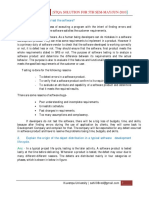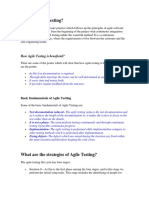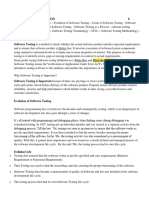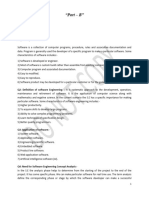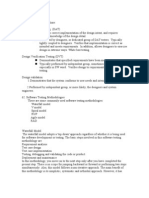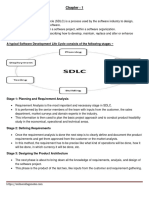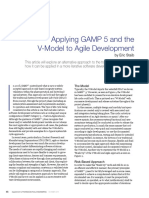0 ratings0% found this document useful (0 votes)
31 viewsExplaining The V-Model A Structured Approach To Software Testing
Uploaded by
codewithtushpatCopyright
© © All Rights Reserved
Available Formats
Download as DOCX, PDF, TXT or read online on Scribd
0 ratings0% found this document useful (0 votes)
31 viewsExplaining The V-Model A Structured Approach To Software Testing
Uploaded by
codewithtushpatCopyright
© © All Rights Reserved
Available Formats
Download as DOCX, PDF, TXT or read online on Scribd
You are on page 1/ 4
Explaining the V-Model: A Structured Approach to
Software Testing
In the realm of software development and quality
assurance, having a well-structured approach is essential
to ensure the reliability and functionality of software
products. One such approach that has gained popularity in
the software testing community is the V-Model. The V-
Model, also known as the Verification and Validation
Model, offers a structured and systematic way to perform
software testing, starting from the earliest stages of
development through to the final product. In this article,
we will delve into the V-Model, its principles, and its
advantages in software testing. If you're seeking the best
software testing training in Lucknow, understanding the V-
Model is an essential component of your education.
Understanding the V-Model
The V-Model is a software development and testing
framework that emphasizes the importance of verification
and validation at each stage of the software development
life cycle (SDLC). This model is called the "V-Model"
because of its visual representation, which resembles the
letter 'V' when diagrammed.
In the V-Model, the left side of the 'V' represents the
development phase, while the right side represents the
testing and validation phase. Each stage on the
development side has a corresponding validation and
testing stage on the right side, forming a symmetrical
structure. This correlation between development and
testing ensures that software is thoroughly examined and
validated at every step of its creation.
Key Principles of the V-Model
1. Sequential Phases: The V-Model promotes a sequential
approach to software development and testing. It begins
with the definition of requirements and proceeds through
design, coding, testing, and deployment. This structured
sequence helps identify and address issues early in the
development process.
2. Validation and Verification: The model emphasizes two
crucial aspects: verification and validation. Verification
ensures that the software is being built correctly according
to the specified requirements. Validation, on the other
hand, confirms that the software meets the customer's
expectations and needs. By considering both aspects, the
V-Model enhances the likelihood of delivering a high-
quality product.
3. Parallel Development and Testing: As development
activities progress on the left side of the 'V,' corresponding
testing activities occur on the right side. This parallel
approach allows for continuous feedback and immediate
correction of issues, reducing the likelihood of defects
being carried forward.
4. Traceability: The V-Model stresses the importance of
traceability, which means that each phase and component
of the software must be traceable back to specific
requirements. This ensures that no functionality is
overlooked, and all requirements are met.
Stages of the V-Model
Let's explore the key stages of the V-Model:
1. Requirements Analysis: This initial phase involves
gathering and analyzing user requirements. It lays the
foundation for the entire development process and serves
as a reference point for subsequent testing stages.
2. System Design: During this phase, the high-level design
of the system is created, outlining how the software will
meet the requirements. It includes architectural design and
module specifications.
3. Module Design: In this stage, the design is broken down
into smaller modules or components. These modules are
developed independently, simplifying the testing process.
4. Coding: The actual coding of the software takes place at
this stage, where developers write the source code. Each
module is coded and tested separately.
5. Unit Testing: Unit testing is the first stage of testing and
occurs at the module level. Each module is tested
individually to ensure it functions correctly.
6. Integration Testing: Modules are integrated to test how
they interact with each other. This stage identifies issues
related to module interactions and data flow.
7. System Testing: The entire system is tested as a whole to
ensure that it functions as intended and meets all
requirements. This stage verifies the system's overall
functionality and reliability.
8. User Acceptance Testing (UAT): UAT is the final stage,
where the software is tested by end-users or stakeholders
to validate that it meets their expectations and
requirements.
9. Deployment: Once the software successfully passes all
testing phases and is approved in UAT, it is deployed to the
production environment.
Benefits of the V-Model
The V-Model offers several advantages when it comes to
software testing and development:
1. Early Detection of Issues: By conducting testing in
parallel with development, issues are identified and
addressed early in the process, reducing the cost and effort
required for later corrections.
2. Improved Quality: The emphasis on both verification and
validation ensures that the software meets specified
requirements and customer expectations, leading to a
higher-quality end product.
3. Effective Communication: Traceability and clear
documentation in the V-Model facilitate effective
communication between development and testing teams,
reducing misunderstandings and errors.
4. Structured Approach: The V-Model provides a systematic
and structured approach to software development, making
it easier to manage and control the entire process.
5. Reduced Risk: The V-Model's systematic approach
reduces the risk of critical issues going unnoticed, leading
to a more robust and reliable software product.
Best Software Testing Training in Lucknow
If you're interested in a career in software testing and
quality assurance, it's crucial to seek the best software
testing training in Lucknow. A comprehensive training
program will equip you with the skills and knowledge
needed to excel in the field. Here are some key aspects to
consider when looking for the best training:
1. Comprehensive Curriculum: The training program
should cover a wide range of testing techniques,
methodologies, and tools, including the V-Model.
2. Experienced Instructors: Look for training institutions
with experienced instructors who have practical industry
knowledge and can provide valuable insights.
3. Hands-on Experience: Practical exercises and real-world
projects should be part of the training to give you hands-on
experience in using the V-Model and other testing
methodologies.
4. Certifications: Training programs that offer recognized
certifications can boost your credibility in the job market.
5. Placement Assistance: Consider programs that offer
placement assistance to help you kick-start your career in
software testing.
Conclusion
The V-Model is a structured approach to software testing
that promotes early verification and validation, reducing
the risk of defects in the final product. If you're considering
a career in software testing, understanding the V-Model is
crucial. When seeking the best software testing training in
Lucknow, ensure that the training program covers this
model and provides you with the skills and knowledge to
excel in the field. The V-Model, with its systematic
approach, is a valuable tool for any software tester,
ensuring the delivery of high-quality, reliable software
products.
You might also like
- Hourglass Workout Program by Luisagiuliet 276% (21)Hourglass Workout Program by Luisagiuliet 251 pages
- The Hold Me Tight Workbook - Dr. Sue Johnson100% (16)The Hold Me Tight Workbook - Dr. Sue Johnson187 pages
- Read People Like A Book by Patrick King-Edited62% (66)Read People Like A Book by Patrick King-Edited12 pages
- Livingood, Blake - Livingood Daily Your 21-Day Guide To Experience Real Health77% (13)Livingood, Blake - Livingood Daily Your 21-Day Guide To Experience Real Health260 pages
- COSMIC CONSCIOUSNESS OF HUMANITY - PROBLEMS OF NEW COSMOGONY (V.P.Kaznacheev,. Л. V. Trofimov.)94% (212)COSMIC CONSCIOUSNESS OF HUMANITY - PROBLEMS OF NEW COSMOGONY (V.P.Kaznacheev,. Л. V. Trofimov.)212 pages
- Donald Trump & Jeffrey Epstein Rape Lawsuit and Affidavits83% (1016)Donald Trump & Jeffrey Epstein Rape Lawsuit and Affidavits13 pages
- The 36 Questions That Lead To Love - The New York Times94% (34)The 36 Questions That Lead To Love - The New York Times3 pages
- The 36 Questions That Lead To Love - The New York Times95% (21)The 36 Questions That Lead To Love - The New York Times3 pages
- Jeffrey Epstein39s Little Black Book Unredacted PDF75% (12)Jeffrey Epstein39s Little Black Book Unredacted PDF95 pages
- Java Spring Boot Enterprise Application DevelopmentNo ratings yetJava Spring Boot Enterprise Application Development4 pages
- The 4 Hour Workweek, Expanded and Updated by Timothy Ferriss - Excerpt23% (954)The 4 Hour Workweek, Expanded and Updated by Timothy Ferriss - Excerpt38 pages
- SQA Interview Preparation by Umar ArshadNo ratings yetSQA Interview Preparation by Umar Arshad91 pages
- Principles, V-Model and Limitations of Software TestingNo ratings yetPrinciples, V-Model and Limitations of Software Testing7 pages
- SE Chapter05 Conventional Methods For Software Engineering Student Copy1No ratings yetSE Chapter05 Conventional Methods For Software Engineering Student Copy116 pages
- What Is Software Testing? and Difference Between Testing and QA?No ratings yetWhat Is Software Testing? and Difference Between Testing and QA?32 pages
- Vocational 12th Class Part Notes by Tariq SirNo ratings yetVocational 12th Class Part Notes by Tariq Sir22 pages
- Software Tester Basics Interview Question and AnswersNo ratings yetSoftware Tester Basics Interview Question and Answers19 pages
- Software Assignment No1 Zohaib Ijaz 23811No ratings yetSoftware Assignment No1 Zohaib Ijaz 2381110 pages
- SWDLC / SDLC: Software Development Life CycleNo ratings yetSWDLC / SDLC: Software Development Life Cycle6 pages
- Manual Testing Interview Questions Jan 2023No ratings yetManual Testing Interview Questions Jan 202319 pages
- Assignment: Software Devolpment Life Cycle100% (1)Assignment: Software Devolpment Life Cycle10 pages
- Quality Assurance Testing from Beginner to Paid Professional, 1: Everything You Need to Know to Start a Career in Manual and Automated QA TestingFrom EverandQuality Assurance Testing from Beginner to Paid Professional, 1: Everything You Need to Know to Start a Career in Manual and Automated QA Testing5/5 (1)
- Tech Odyssey Unlocking Opportunities For Full Stack Wizards in The Heart of Lucknow's Digital RevolutionNo ratings yetTech Odyssey Unlocking Opportunities For Full Stack Wizards in The Heart of Lucknow's Digital Revolution3 pages
- Unleashing The Data Revolution NLP's Dynamic Impact On Data ScienceNo ratings yetUnleashing The Data Revolution NLP's Dynamic Impact On Data Science3 pages
- Precision Unleashed Mastering Data Quality For Unrivaled Analytics ExcellenceNo ratings yetPrecision Unleashed Mastering Data Quality For Unrivaled Analytics Excellence3 pages
- From Novice To Full-Stack Pro Navigating Your Development JourneyNo ratings yetFrom Novice To Full-Stack Pro Navigating Your Development Journey5 pages
- Unlock Insights With AB Testing Data-Driven Decision MakingNo ratings yetUnlock Insights With AB Testing Data-Driven Decision Making5 pages
- Python and Competitive Programming Mastering Coding Challenges in NagpurNo ratings yetPython and Competitive Programming Mastering Coding Challenges in Nagpur4 pages
- Unleashing The Power of Java in Database DomainsNo ratings yetUnleashing The Power of Java in Database Domains4 pages
- Smart Strategies For Successful Data Analytics ImplementationNo ratings yetSmart Strategies For Successful Data Analytics Implementation3 pages
- Understand Inheritance and Polymorphism in JavaNo ratings yetUnderstand Inheritance and Polymorphism in Java4 pages
- Python GUI Programming Tkinter and BeyondNo ratings yetPython GUI Programming Tkinter and Beyond6 pages
- Deep Learning For Predictive Data Analytics A Path To ExcellenceNo ratings yetDeep Learning For Predictive Data Analytics A Path To Excellence5 pages
- Deep Learning With Python and TensorFlow KerasNo ratings yetDeep Learning With Python and TensorFlow Keras4 pages
- Optimizing Database Queries For Full-Stack PerformanceNo ratings yetOptimizing Database Queries For Full-Stack Performance4 pages
- JavaFX Building Rich User Interfaces With JavaNo ratings yetJavaFX Building Rich User Interfaces With Java3 pages
- Python Mastery Unleashed Transform Your Tech Journey With Gurgaon's Premier Training Hub!No ratings yetPython Mastery Unleashed Transform Your Tech Journey With Gurgaon's Premier Training Hub!4 pages
- Full Stack Development Trends What's On The HorizonNo ratings yetFull Stack Development Trends What's On The Horizon4 pages
- Data Analytics Tools A Comprehensive OverviewNo ratings yetData Analytics Tools A Comprehensive Overview6 pages
- Empowering Your Development Journey Choosing The Right Full Stack Framework StackNo ratings yetEmpowering Your Development Journey Choosing The Right Full Stack Framework Stack6 pages
- Python and Competitive Programming Mastering Coding Challenges in NagpurNo ratings yetPython and Competitive Programming Mastering Coding Challenges in Nagpur5 pages
- Data Science vs. Data Analytics Understanding The DifferencesNo ratings yetData Science vs. Data Analytics Understanding The Differences5 pages
- Algorithmic Excellence Choosing The Right Algorithms For Python OptimizationNo ratings yetAlgorithmic Excellence Choosing The Right Algorithms For Python Optimization4 pages
- Exploratory Testing in Agile Uncovering Hidden BugsNo ratings yetExploratory Testing in Agile Uncovering Hidden Bugs5 pages
- Blockchain and Data Science Ensuring Data Integrity and SecurityNo ratings yetBlockchain and Data Science Ensuring Data Integrity and Security5 pages
- Systems Engineering For Dummies Ibm Limited Systems Engineering For DummiesNo ratings yetSystems Engineering For Dummies Ibm Limited Systems Engineering For Dummies76 pages
- Institute of Technology Department of Electrical and Computer Engineering (Computer Focus Area) Online Voting System of Ethiopian GovernmentNo ratings yetInstitute of Technology Department of Electrical and Computer Engineering (Computer Focus Area) Online Voting System of Ethiopian Government16 pages
- Livingood, Blake - Livingood Daily Your 21-Day Guide To Experience Real HealthLivingood, Blake - Livingood Daily Your 21-Day Guide To Experience Real Health
- COSMIC CONSCIOUSNESS OF HUMANITY - PROBLEMS OF NEW COSMOGONY (V.P.Kaznacheev,. Л. V. Trofimov.)COSMIC CONSCIOUSNESS OF HUMANITY - PROBLEMS OF NEW COSMOGONY (V.P.Kaznacheev,. Л. V. Trofimov.)
- Donald Trump & Jeffrey Epstein Rape Lawsuit and AffidavitsDonald Trump & Jeffrey Epstein Rape Lawsuit and Affidavits
- The 36 Questions That Lead To Love - The New York TimesThe 36 Questions That Lead To Love - The New York Times
- The 36 Questions That Lead To Love - The New York TimesThe 36 Questions That Lead To Love - The New York Times
- Jeffrey Epstein39s Little Black Book Unredacted PDFJeffrey Epstein39s Little Black Book Unredacted PDF
- Java Spring Boot Enterprise Application DevelopmentJava Spring Boot Enterprise Application Development
- The 4 Hour Workweek, Expanded and Updated by Timothy Ferriss - ExcerptThe 4 Hour Workweek, Expanded and Updated by Timothy Ferriss - Excerpt
- Principles, V-Model and Limitations of Software TestingPrinciples, V-Model and Limitations of Software Testing
- SE Chapter05 Conventional Methods For Software Engineering Student Copy1SE Chapter05 Conventional Methods For Software Engineering Student Copy1
- What Is Software Testing? and Difference Between Testing and QA?What Is Software Testing? and Difference Between Testing and QA?
- Software Tester Basics Interview Question and AnswersSoftware Tester Basics Interview Question and Answers
- Quality Assurance Testing from Beginner to Paid Professional, 1: Everything You Need to Know to Start a Career in Manual and Automated QA TestingFrom EverandQuality Assurance Testing from Beginner to Paid Professional, 1: Everything You Need to Know to Start a Career in Manual and Automated QA Testing
- Tech Odyssey Unlocking Opportunities For Full Stack Wizards in The Heart of Lucknow's Digital RevolutionTech Odyssey Unlocking Opportunities For Full Stack Wizards in The Heart of Lucknow's Digital Revolution
- Unleashing The Data Revolution NLP's Dynamic Impact On Data ScienceUnleashing The Data Revolution NLP's Dynamic Impact On Data Science
- Precision Unleashed Mastering Data Quality For Unrivaled Analytics ExcellencePrecision Unleashed Mastering Data Quality For Unrivaled Analytics Excellence
- From Novice To Full-Stack Pro Navigating Your Development JourneyFrom Novice To Full-Stack Pro Navigating Your Development Journey
- Unlock Insights With AB Testing Data-Driven Decision MakingUnlock Insights With AB Testing Data-Driven Decision Making
- Python and Competitive Programming Mastering Coding Challenges in NagpurPython and Competitive Programming Mastering Coding Challenges in Nagpur
- Smart Strategies For Successful Data Analytics ImplementationSmart Strategies For Successful Data Analytics Implementation
- Deep Learning For Predictive Data Analytics A Path To ExcellenceDeep Learning For Predictive Data Analytics A Path To Excellence
- Optimizing Database Queries For Full-Stack PerformanceOptimizing Database Queries For Full-Stack Performance
- Python Mastery Unleashed Transform Your Tech Journey With Gurgaon's Premier Training Hub!Python Mastery Unleashed Transform Your Tech Journey With Gurgaon's Premier Training Hub!
- Full Stack Development Trends What's On The HorizonFull Stack Development Trends What's On The Horizon
- Empowering Your Development Journey Choosing The Right Full Stack Framework StackEmpowering Your Development Journey Choosing The Right Full Stack Framework Stack
- Python and Competitive Programming Mastering Coding Challenges in NagpurPython and Competitive Programming Mastering Coding Challenges in Nagpur
- Data Science vs. Data Analytics Understanding The DifferencesData Science vs. Data Analytics Understanding The Differences
- Algorithmic Excellence Choosing The Right Algorithms For Python OptimizationAlgorithmic Excellence Choosing The Right Algorithms For Python Optimization
- Exploratory Testing in Agile Uncovering Hidden BugsExploratory Testing in Agile Uncovering Hidden Bugs
- Blockchain and Data Science Ensuring Data Integrity and SecurityBlockchain and Data Science Ensuring Data Integrity and Security
- Systems Engineering For Dummies Ibm Limited Systems Engineering For DummiesSystems Engineering For Dummies Ibm Limited Systems Engineering For Dummies
- Institute of Technology Department of Electrical and Computer Engineering (Computer Focus Area) Online Voting System of Ethiopian GovernmentInstitute of Technology Department of Electrical and Computer Engineering (Computer Focus Area) Online Voting System of Ethiopian Government

































